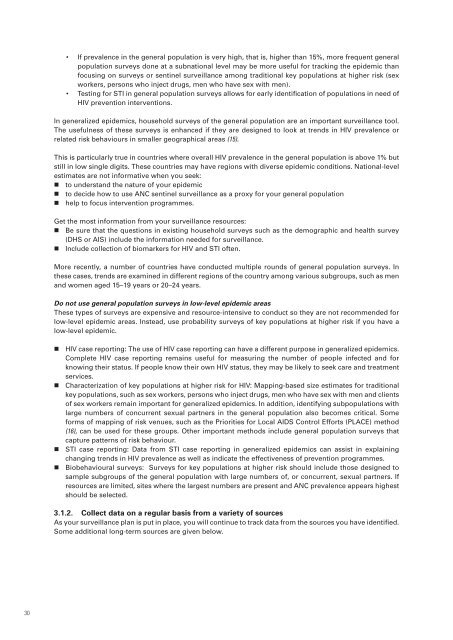Guidelines for second generation HIV surveillance - World Health ...
Guidelines for second generation HIV surveillance - World Health ...
Guidelines for second generation HIV surveillance - World Health ...
Create successful ePaper yourself
Turn your PDF publications into a flip-book with our unique Google optimized e-Paper software.
• If prevalence in the general population is very high, that is, higher than 15%, more frequent general<br />
population surveys done at a subnational level may be more useful <strong>for</strong> tracking the epidemic than<br />
focusing on surveys or sentinel <strong>surveillance</strong> among traditional key populations at higher risk (sex<br />
workers, persons who inject drugs, men who have sex with men).<br />
• Testing <strong>for</strong> STI in general population surveys allows <strong>for</strong> early identification of populations in need of<br />
<strong>HIV</strong> prevention interventions.<br />
In generalized epidemics, household surveys of the general population are an important <strong>surveillance</strong> tool.<br />
The usefulness of these surveys is enhanced if they are designed to look at trends in <strong>HIV</strong> prevalence or<br />
related risk behaviours in smaller geographical areas (15).<br />
This is particularly true in countries where overall <strong>HIV</strong> prevalence in the general population is above 1% but<br />
still in low single digits. These countries may have regions with diverse epidemic conditions. National-level<br />
estimates are not in<strong>for</strong>mative when you seek:<br />
• to understand the nature of your epidemic<br />
• to decide how to use ANC sentinel <strong>surveillance</strong> as a proxy <strong>for</strong> your general population<br />
• help to focus intervention programmes.<br />
Get the most in<strong>for</strong>mation from your <strong>surveillance</strong> resources:<br />
• Be sure that the questions in existing household surveys such as the demographic and health survey<br />
(DHS or AIS) include the in<strong>for</strong>mation needed <strong>for</strong> <strong>surveillance</strong>.<br />
• Include collection of biomarkers <strong>for</strong> <strong>HIV</strong> and STI often.<br />
More recently, a number of countries have conducted multiple rounds of general population surveys. In<br />
these cases, trends are examined in different regions of the country among various subgroups, such as men<br />
and women aged 15–19 years or 20–24 years.<br />
Do not use general population surveys in low-level epidemic areas<br />
These types of surveys are expensive and resource-intensive to conduct so they are not recommended <strong>for</strong><br />
low-level epidemic areas. Instead, use probability surveys of key populations at higher risk if you have a<br />
low-level epidemic.<br />
• <strong>HIV</strong> case reporting: The use of <strong>HIV</strong> case reporting can have a different purpose in generalized epidemics.<br />
Complete <strong>HIV</strong> case reporting remains useful <strong>for</strong> measuring the number of people infected and <strong>for</strong><br />
knowing their status. If people know their own <strong>HIV</strong> status, they may be likely to seek care and treatment<br />
services.<br />
• Characterization of key populations at higher risk <strong>for</strong> <strong>HIV</strong>: Mapping-based size estimates <strong>for</strong> traditional<br />
key populations, such as sex workers, persons who inject drugs, men who have sex with men and clients<br />
of sex workers remain important <strong>for</strong> generalized epidemics. In addition, identifying subpopulations with<br />
large numbers of concurrent sexual partners in the general population also becomes critical. Some<br />
<strong>for</strong>ms of mapping of risk venues, such as the Priorities <strong>for</strong> Local AIDS Control Ef<strong>for</strong>ts (PLACE) method<br />
(16), can be used <strong>for</strong> these groups. Other important methods include general population surveys that<br />
capture patterns of risk behaviour.<br />
• STI case reporting: Data from STI case reporting in generalized epidemics can assist in explaining<br />
changing trends in <strong>HIV</strong> prevalence as well as indicate the effectiveness of prevention programmes.<br />
• Biobehavioural surveys: Surveys <strong>for</strong> key populations at higher risk should include those designed to<br />
sample subgroups of the general population with large numbers of, or concurrent, sexual partners. If<br />
resources are limited, sites where the largest numbers are present and ANC prevalence appears highest<br />
should be selected.<br />
3.1.2. Collect data on a regular basis from a variety of sources<br />
As your <strong>surveillance</strong> plan is put in place, you will continue to track data from the sources you have identified.<br />
Some additional long-term sources are given below.<br />
30
















